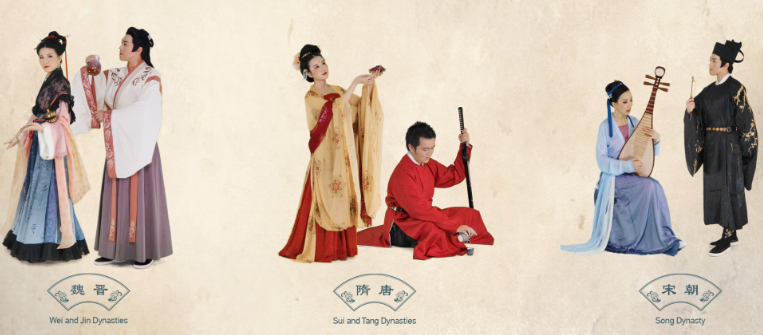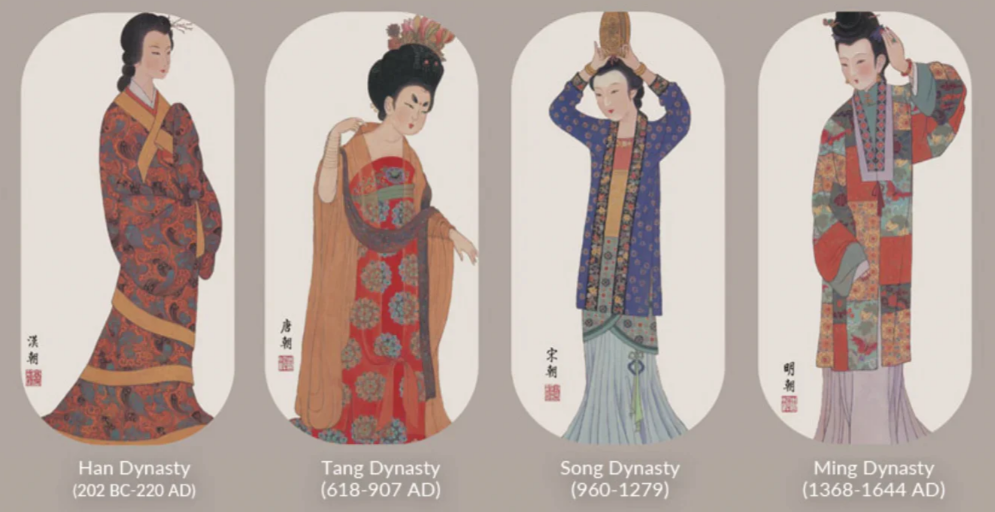Identify Hanfu by examining fabric, color, garment structure, and ornamental details unique to each Chinese dynasty.
Overview of Hanfu Through Dynasties
The Evolution of Hanfu Styles
Hanfu, the traditional clothing of the Han Chinese, mirrors the cultural and political shifts in China with its remarkable transformation over centuries. Starting in the Xia and Shang Dynasties, Hanfu was primarily a simple tunic-like garment. The Zhou Dynasty marked a significant shift towards layered and sophisticated designs, introducing the Yi (衣, open cross-collar garment) and Shang (裳, skirt), forming the foundation of traditional Hanfu.
In the Han Dynasty, often considered the golden age of Hanfu, the attire became a symbol of Chinese identity. Hanfu from this era featured a cross-collar with a right lapel, tied with a sash. Silk use became more prominent, reflecting China’s growing prosperity and sericulture advancements.
The Tang Dynasty, known for its cultural openness and prosperity, brought an explosion of styles, colors, and designs to Hanfu. This era is famous for introducing the wide-sleeved Ruqun (襦裙) and the Beizi (背子), a jacket-like garment. Women’s Hanfu became more elaborate, with high-waisted dresses and flowing sleeves, showcasing the Tang Dynasty’s liberal attitudes.
The Song and Ming Dynasties returned to conservatism in Hanfu styles. The Song Dynasty favored modesty and simplicity, evident in the commonly worn Zhiju (直裾), a straight-hemmed robe. The Ming Dynasty revived traditional Hanfu elements, emphasizing symmetry and straight lines in the Aoqun (袄裙) style.

Key Characteristics of Hanfu in Major Dynasties
Han Dynasty Hanfu is distinct with its simplicity and practicality. The typical Hanfu silhouette was straight and loose, allowing for ease of movement. Silk, while popular, was not the only fabric; hemp and linen were widely used among the common populace. The colors were generally muted, with occasional bright accents for the upper class.
Tang Dynasty Hanfu stands out for its elegance and extravagance. This era witnessed the integration of foreign elements into Hanfu, reflecting the cosmopolitan nature of Tang society. Luxurious fabrics like brocade and intricate patterns and vibrant colors were prevalent. Women’s dresses had high waists and round collars, often accompanied by wide sleeves.
In the Song Dynasty, Hanfu became more refined and conservative. The emphasis was on straight lines and understated elegance. Song Dynasty Hanfu often featured a narrow sleeve and a modest neckline. Colors remained relatively subdued, but with more variety than in the Han Dynasty.
Ming Dynasty Hanfu is known for its revival of traditional elements. Ming Dynasty Hanfu is characterized by symmetrical design and the use of thicker fabrics. The dominant style was the Aoqun, consisting of a jacket (Ao) and a skirt (Qun). Layering was prevalent, with different fabrics like cotton and silk being used together.
These styles reflect not only the aesthetic preferences of their times but also the socio-political and cultural contexts that shaped them. By studying these variations, we gain a deeper understanding of Chinese history and the evolution of its rich sartorial traditions. Research and surveys by organizations like the Chinese National Garment Association highlight the growing interest and revival of traditional Hanfu, indicating a resurgence in cultural pride and identity among modern Chinese youth.
Distinctive Features of Hanfu in Specific Dynasties
Han Dynasty
The Han Dynasty marks the beginning of the Hanfu tradition with its emphasis on simplicity and elegance. The attire of this era, characterized by its minimalistic design, promoted comfort and ease of movement. Typically, Hanfu featured a Y-shaped cross collar, creating a harmonious silhouette. Fabrics mainly included silk, but also hemp and linen, catering to different social classes. Colors were predominantly muted, with occasional use of brighter hues for the upper class. This era’s clothing reflects the Han Dynasty’s values of modesty and understatement.
Tang Dynasty
The Tang Dynasty is renowned for its flourishing diversity and extravagance in Hanfu styles. This period saw an unprecedented fusion of foreign fashion elements, reflecting the Tang Empire’s extensive trade and cultural exchanges. Women’s attire often featured high-waisted dresses, round collars, and wide sleeves, symbolizing the era’s liberal attitude. The use of luxurious fabrics like silk brocade and vibrant colors became widespread. This period’s clothing not only exhibits the dynasty’s wealth and power but also its open-mindedness and cosmopolitan nature.
Song Dynasty
During the Song Dynasty, Hanfu evolved into more refined and subtle elegance. The clothing of this period favored straight lines and a modest appearance, aligning with the era’s conservative cultural values. Song Dynasty attire often featured narrow sleeves, high collars, and subtle colors, reflecting a preference for understated beauty. This period’s fashion emphasizes the importance of modesty and restraint in traditional Chinese culture.
Ming Dynasty
The Ming Dynasty witnessed a return to classical styles, reviving many traditional elements of Hanfu. This era’s clothing emphasized symmetrical designs and sturdy fabrics like cotton and silk. The Ming Dynasty Hanfu, especially the Aoqun, became emblematic of traditional Chinese attire. It showcased the era’s respect for historical customs and a desire to preserve China’s sartorial heritage.
| Dynasty | Style Description | Fabric | Colors | Key Features |
|---|---|---|---|---|
| Han | Simple and Elegant | Silk, Hemp, Linen | Muted with Bright Accents for Upper Class | Y-shaped Cross Collar, Minimalistic Design |
| Tang | Diverse and Extravagant | Silk Brocade | Vibrant | High-Waisted Dresses, Round Collars, Wide Sleeves |
| Song | Refined and Subtle | Silk, Linen | Subtle | Narrow Sleeves, High Collars |
| Ming | Classical Revival | Cotton, Silk | Varied | Symmetrical Designs, Aoqun Style |
This table provides a comparative overview of Hanfu styles across these dynasties, highlighting the distinct features and cultural significances of each era. By examining these details, one gains a deeper appreciation of the rich tapestry of Chinese history and fashion. These dynastic styles not only reflect aesthetic preferences but also the socio-political and cultural dynamics of their respective periods.
Comparative Analysis of Hanfu Across Dynasties
Fabric and Color Variations
The choice of fabric and color in Hanfu provides a vivid reflection of the cultural and economic aspects of each dynasty. In the Han Dynasty, silk, hemp, and linen were prevalent, with silk symbolizing status and wealth. The colors were generally muted, embodying the era’s value of modesty. As trade routes expanded during the Tang Dynasty, more luxurious and diverse fabrics like silk brocade came into use. Colors became more vibrant and varied, reflecting the dynasty’s cosmopolitan nature and cultural openness.
The Song Dynasty saw a preference for subtler colors and high-quality silk and linen, aligning with its conservative and refined cultural ethos. During the Ming Dynasty, there was a notable use of heavier fabrics like cotton, combined with silk, showcasing a blend of practicality and elegance. The colors varied more than in previous dynasties, reflecting a respect for tradition coupled with an appreciation for innovation.
Differences in Garment Structure and Design
Hanfu’s garment structure and design underwent significant changes over the dynasties, reflecting evolving aesthetic tastes and social norms. The Han Dynasty favored a simplistic and practical structure, with loose-fitting robes that facilitated ease of movement. The Tang Dynasty’s Hanfu, in contrast, displayed an array of designs, from the high-waisted Ruqun to the wide-sleeved Beizi, reflecting the era’s flamboyant spirit and openness to diverse influences.
In the Song Dynasty, the design shifted towards more conservative and understated styles, with garments like the Zhiju robe exemplifying this trend. The Ming Dynasty saw a revival of traditional elements, with a focus on symmetry and a return to the classical Aoqun style. These structural and design changes provide insights into the shifting social and cultural dynamics of each period.
Ornamentation and Symbolism
Ornamentation and symbolism in Hanfu play a crucial role in conveying the cultural values and beliefs of the respective dynasties. During the Han Dynasty, ornamentation was minimal, reflecting the era’s emphasis on simplicity. However, symbolic elements like dragon and phoenix motifs were used, particularly among the nobility, to denote power and status.
The Tang Dynasty introduced more elaborate ornamentations, with floral patterns, animal motifs, and intricate embroideries, mirroring the dynasty’s wealth and openness to foreign influences. In the Song Dynasty, ornamentation became more subtle, often incorporating symbolic patterns that conveyed moral values and philosophical ideals.
The Ming Dynasty combined the simplicity of earlier styles with the extravagance of the Tang, using ornamentation to symbolize social status and cultural identity. This era saw a resurgence in the use of traditional motifs, such as lotus flowers and cloud patterns, which held significant cultural and symbolic meaning.
These comparative analyses of Hanfu across dynasties reveal not just changes in fashion but also provide a window into the cultural, social, and economic shifts in Chinese history. Each dynasty’s distinct approach to fabric choice, garment design, and ornamentation offers a rich tapestry of information about their values, beliefs, and way of life. Understanding these nuances enhances our appreciation of the sophistication and depth of Chinese cultural heritage.

Practical Guide to Identifying Hanfu by Dynasty
Visual Guides and Key Identifiers
Identifying Hanfu from different dynasties involves understanding key visual elements and styles. For the Han Dynasty, look for simple, straight-lined robes with a cross collar and sash. These garments often feature minimal ornamentation and are made from silk, hemp, or linen. The colors are usually muted, though upper-class garments may include bright accents.
In the Tang Dynasty, Hanfu becomes more flamboyant. Key identifiers include high-waisted dresses, round collars, and wide sleeves for women, and more elaborate patterns and colors. The use of luxurious fabrics like silk brocade is a hallmark of this era.
Song Dynasty Hanfu is characterized by its refined elegance. Garments often feature narrow sleeves, high collars, and subtle colors. The overall look is more conservative and understated compared to the Tang Dynasty.
For the Ming Dynasty, look for the classical Aoqun style, with its symmetrical design and the use of thicker fabrics like cotton and silk. The colors are varied, but the designs often include traditional motifs and patterns.
Tips for Beginners in Hanfu Identification
For beginners in Hanfu identification, start by familiarizing yourself with the basic silhouette of each dynasty’s garments. Compare the collar styles, sleeve widths, and garment lengths across different periods. Pay attention to fabric types and colors, as these are key indicators of the era. Practicing by looking at pictures or illustrations of Hanfu from different dynasties can help in developing a keen eye for these details.
It’s also helpful to learn about the historical and cultural contexts of each period, as this knowledge can provide insights into why certain styles and designs were prevalent. Joining online forums or communities dedicated to traditional Chinese fashion can provide valuable resources and advice from more experienced enthusiasts.
Resources and References for Further Learning
For further learning, there are several resources available. Books on Chinese fashion history can provide detailed insights into Hanfu across different dynasties. Online platforms like Wikipedia offer comprehensive information on the historical context and evolution of Hanfu. Websites and forums dedicated to traditional Chinese culture and fashion can be excellent places to find visual guides and discussions. Museums with Chinese fashion exhibits or collections are also invaluable for seeing real examples of Hanfu and understanding their craftsmanship and beauty in person.
Incorporating these methods and resources, beginners and enthusiasts alike can deepen their understanding and appreciation of Hanfu, gaining the ability to identify and appreciate the rich heritage and artistry involved in traditional Chinese clothing. This journey into the world of Hanfu not only enhances one’s knowledge of fashion history but also offers a window into the cultural and historical tapestry of China.